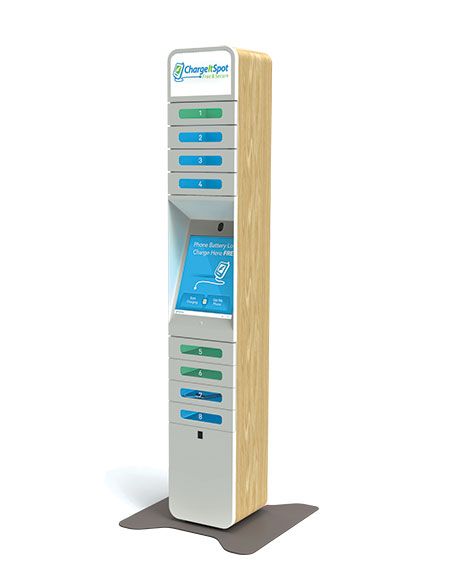Ours is the age of online shopping. This year, Black Friday internet sales jumped 28 percent over last year as consumers spent $3.7 billion online. In fact, many buyers abandoned desktops and tablets for their online purchases, turning to their phones instead. The trend isn’t new: Retail brands have been adjusting their strategies for years now, ramping up their online presences and capabilities and adopting internet-influenced tactics like mobile in-store checkout and drive-by pickup in their brick-and-mortar stores.
As it’s becoming increasingly evident that on-site retailers will continue to struggle against the behemoth that is online shopping, they will do whatever they can to get (and keep) consumers inside their stores. One emerging method: providing phone chargers. The lockers that charge phones are showing up in more and more stores in hopes of luring consumers who can’t bear the thought of a dead battery. Last year, Target installed ChargeItSpot machines in nearly 200 locations across the United States. The machines charge shoppers’ phones for free while also securing them. A Target rep says ChargeItSpot is especially popular in urban areas, where people are getting to the stores on foot and thus unable to charge their phones while driving to the store. “Since we started offering these kiosks in 2017, guests have charged their phones hundreds of thousands of times,” says Target representative Jacqueline DeBuse.

ChargeItSpot recently commissioned a white paper (with the help of the Wharton School, Helios Analytics, and consumer research firm GfK) on how its availability in retail shops affects the consumer experience. It studied the reactions of shoppers who used ChargeItSpot versus those who were met with stations that were already full. “Shoppers who dwell longer in store (and without their phones serving as a distraction) should also be likely to increase purchase consideration, resulting in a higher conversion rate and total spend at checkout,” the report hypothesized. The result: Customers who shopped without their phones spent more time and money in stores.
The concept shares some principles with a growing movement to eliminate, or at least reduce, smartphone use in public spaces. The idea is that to regain some self-control and free ourselves from our phones, we should, at times, surrender them. People need to engage in real conversation, make eye contact, and enjoy the moment without documenting it, and one way to do so is to take away their damned devices. It’s a valiant idea, with a few challenges—namely, smartphones can also be helpful. We may be gaining freedom from our phones, but only to offer it instead to retailers. For one thing, a locked-up phone means the customer can’t comparison-shop online or check for coupons while shopping.
In non-retail spaces, though, charger stations don’t necessarily free up a person’s purse strings so much as their attention spans. Cisco Seader works in business development for InCharged, which manufactures chargers and locker solutions (among other services — including a photo booth, of course) for a variety of clients. Its most popular product is its flagship charging station, the Flex S, which is little more than a tower with protruding cords and a base to set phones on; it’s not a locker, so users are likely to stand guard while charging. It’s a popular model, often seen in public spaces like airports and convention halls. Seader says that while his company largely caters to trade shows and other events, they’ve also worked with music festivals, hospitals, municipal buildings, libraries, schools, as well as some retail companies. “It’s kind of opened up in the past few years,” he says, adding that InCharged has been in talks with Mall of America to install its stations.

Seader’s anecdotal observations echo ChargeItSpot’s research: “[Our clients] keep customers at the site for a longer period of time,” he says. “It’s kind of like an excuse to stick around a little longer.” Ioli Macridi, a research analyst at Edge by Ascential, agrees. She told me via email that just knowing a retail space has chargers could encourage someone to make a purchase while their phone juices up, even if they weren’t originally intending to. “Having a phone run out of battery in the middle of a shopping trip may be a reason for the shopper to abandon the trip, so offering on-site charging can be an advantage,” she wrote. Retail analyst Florence Wright, also with Edge by Ascential, says that charging stations can influence people to make impulse purchases in places like airports; maybe a person had no interest in buying anything, but once that phone is plugged in and out of their hands, that keychain-shot-glass combo suddenly becomes interesting.
Charging stations also make customers remember a space for the courtesy factor — it’s an amenity that increases its value. “You stay in their minds, because they’re going to remember you helped them out,” says Seader. As retail spaces continue to evolve, and look less and less like traditional brick-and-mortar shops and more like lifestyle-magazine tableaux, elements like chargers and beyond will become increasingly important. Wright says chargers are part of the pursuit of “experiential retail” — in other words, retail spaces that share space with or include things like cafes, lounges, or work stations. “We are seeing the emergence of new urban convenience store concepts which aim to combine work, shopping, and leisure,” she says, pointing to European places like Carrefour Express Urban Life in Milan and Le 4 Casino in Paris. She, too, mentions the drive to increase “dwell time.” And to compete with online shopping, retail’s future depends largely on technology — and that, as Wright points out, means shoppers will need charged phones. Digital couponing, loyalty card apps, mobile checkout, and the forthcoming arrival of augmented-reality options will require that their users have working phones.
There is a trade-off to using many of these machines, and as usual, it’s customer data. “Most kiosks ask optional survey questions before allowing the user to start charging,” Macridi says. Information could include phone numbers or emails, gender, product preferences, and so on. This could allow the retailer to send promotional emails to users, or even gather data in order to recommend projects or advertise. To that end, InCharge’s machines even include marketing and branding spaces for their corporate clients, a sort of two-birds-one-stone mentality. “It’s a double opportunity: You’re providing a great service but also providing eyeballs to your brand,” says Seader.
Aside from the myriad benefits of charger installations to retailers, the fact is that docking your phone while you shop could be helping people create a little, momentary distance from their devices. Without your smartphone, you may become a better consumer, but also be more present in general: freer to listen, take in information, and assess what you’re doing. “Let’s be honest, even though they’re super useful, [phones] are a huge distraction,” says Seader. At trade shows where InCharged devices are used, he says, exhibitors say that consumers seem more engaged. Another option: Just let your phone die, or leave it at home. Admittedly, we’re not quite there yet.

